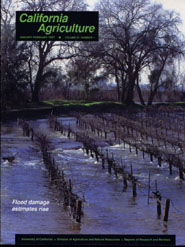All Issues

In southern Sacramento County, a private levee burst and allowed the Mokelumne River to flood this vineyard. January flood damage to winegrapes statewide was estimated at $13.8 million by the California Department of Food and Agriculture. Photo by Jack Kelly Clark






Volume 51, Number 1





